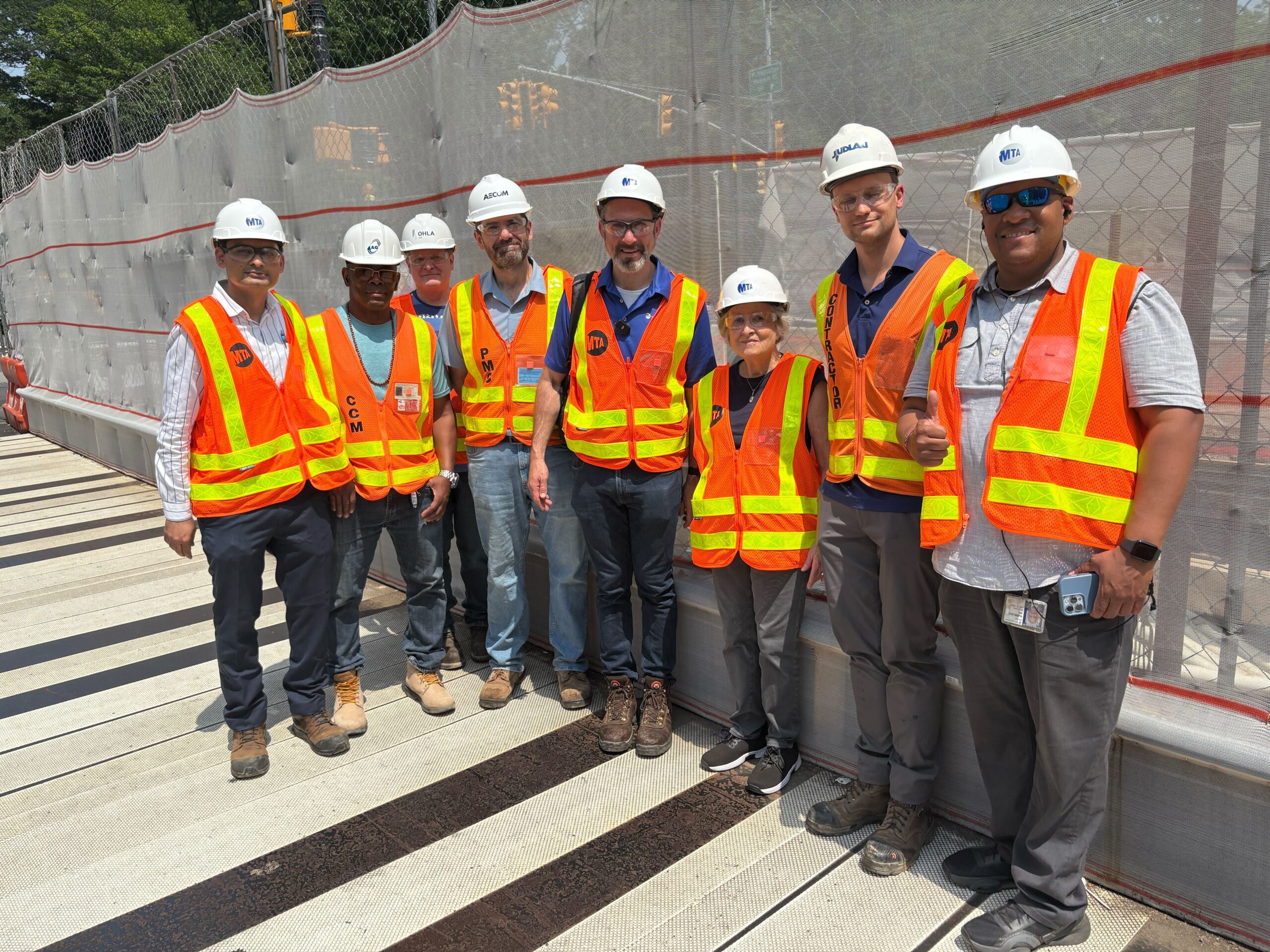
By Carol Tannenhauser
I live across the street from the West 81st Street-Museum of Natural History subway station, where the Metropolitan Transportation Authority is currently installing an elevator.
When work began in September, 2024, the MTA said it would take two years to complete. Last week, Jamie Torres-Springer, president of MTA Construction & Development, one of the five operating agencies within the MTA, told the Rag it should be done by the middle or end of 2026, putting it pretty much on schedule. Torres-Springer also noted that work on the elevator has just entered the excavation phase.
He didn’t have to tell me. I had recently become aware of a relentless, repetitive sound outside my window, like a gigantic woodpecker, only his beak is made of metal and instead of wood, he’s pecking away at solid rock.
Actually, I didn’t notice it until a neighbor pointed it out. Now it’s all I hear. I don sound-canceling headphones, but they just make the pecking softer. It is consistent, from 7 a.m. to 3 p.m., but for brief intervals when it stops. I hold my breath and wait.
It begins again.

“These guys have to figure out how to excavate, how to dig out 40 more feet of rock,” Torres-Springer explained, as I toured the construction site with him the other day. “And that rock is not just any old rock. It’s Manhattan schist. You look at Central Park over there, you know those big boulders? That’s Manhattan schist.”
One of the workers on the tour elaborated. “It’s harder to excavate Manhattan schist than anything else,” he said. “It’s so hard it makes it impossible to break with regular methodologies. For the majority of the work, you have to drill a series of holes. Right now we’re working at about 18 inches on center in a diamond pattern. And then you split it.”
I had a little trouble grasping the diamond-pattern explanation, but no trouble at all understanding what Torres-Springer told me next:
“It’ll take us probably another two-and-a-half months to get to the very bottom,” he said.
Two-and-a-half more months of the woodpecker, I thought.
“We’ve put up sound barriers around the entire perimeter to absorb and dampen the noise as much as possible,” Torres-Springer went on. “And as we go deeper, that noise should become less and less and less, because it’s going to be further away.”
I assured him that I am an avid supporter of the elevator and believe a few months of noise is a reasonable price to pay for subway accessibility, especially next to one of the great museums of the neighborhood and world.
The noise issue aside, I have watched the construction from my window and been surprised and impressed by how neat and efficient it has been. (I think of one worker we passed on the tour, carefully sweeping the perimeter of the site. Everyone has their job and does it.) I have new respect for the construction industry and the MTA – and what is required to build a subway elevator.

In this case, there was a lot of preparation work. A bus stop had to be moved, along with tangles of wires, cables and pipes. And a pedestrian bridge had to be built across the gaping hole, so 81st Street could still be crossed.
It takes more than just an elevator to make a subway station accessible. “The cost of the elevator is 10% of the project,” Torres-Springer said. In the case of West 81st Street, the other 90% (of the total cost of $50 million) is going to an array of accessibility-related improvements, including repairing two existing staircases that descend to the subway from 81st, which are 100 years old. And a whole new staircase will be added.
“As a user of the station, you know there’s not enough stairs, right?” Torres-Springer asked. “Everybody gets off the train during rush hour and you’re all standing there on the platform waiting to get on the stairs. So we’re adding a whole other staircase, which will help people get out of the station faster.”
The platforms also have an ADA (Americans with Disabilities Act) element. They, too, are 100 years old, Torres-Springer pointed out. “They have to be made flat. They have to align better with the train so that if you’re in a wheelchair, you’re able to just roll into the car,” he said.
There will also be some “track work,” he added. “And that’s just the basic stuff. In order to do all this, we have to build all kinds of electrical systems, control rooms, communication rooms, add fire devices, fire alarms, and connect it up with our rail control center.”

There are 472 subway stations in the New York City system, 144 of which are fully ADA accessible. Right now, 43 more are being made accessible, either through elevators or ramps (which are much cheaper but not appropriate for many stations that run too deep). On the Upper West Side, the 96th Street-Central Park West station is also in the midst of an elevator installation.
It’s an enormous job, but one that, according to Torres-Springer, is being done faster and cheaper than in the past. “We’ve reorganized our whole agency. We’re very focused on getting things done on time and on budget,” he said.
He believes New York state lawmakers and Gov. Kathy Hochul recognized this when they decided at the end of April to fully fund the MTA’s new five-year capital plan, a record $68.4 billion. “About $7 billion of that money will be used to make at least 60 more subway stations and six rail stations accessible to people with disabilities,” the New York Times reported.
“We have to do it,” Torres-Springer said.. “We have a commitment to get to 95% of our stations by 2055.”

Subscribe to West Side Rag’s FREE email newsletter here. And you can Support the Rag here.










JTS – can you make the staircases on the W72nd St platform a little wider please?
“We have to do it,” Torres-Springer said.. “We have a commitment to get to 95% of our stations by 2055.”
What is the rush ?
Its called federal law, The ADA Act
…of 1990. It’s already been 35 years!
Perhaps if you weren’t, say, able-bodied, or if you had the responsibility of moving your own or someone else’s child about in a cart, you might better understand ~the rush~. Try putting yourself in someone else’s shoes and understanding that public projects are for everyone’s benefit (even tourists!), among whom are many people who face greater challenges with mobility than you in their day-to-day lives.
And in the case no one ever taught you, when you’re on the train or bus, you should stand up to let them sit down.
Anyone familiar with sarcasm ?
30 year timeline for this is ridiculous.
Sarcasm is pretty tired, person… Try sincerity! Goes a long way.
Apology accepted.
I think the article explained what a large undertaking is required to upgrade one station.
All this for this? At the end it would be cheaper for all of us for some to just take cabs…
Maybe they can’t afford it. And there are not enough transport services to help everyone who needs it. Try moving into the 21st century.
I studied this in grad school as far back as 1974. Analysis after analysis always showed that it’s cheaper to provide subsidized surface transit for the disabled than to retrofit the infrastructure.
The argument is and always has been that the disabled deserve equal opportunity to enjoy existing facilities and, for better or worse, that argument won. IF for example you consider the ability of a disabled person to travel with their able bodied friends and family? If, for example you consider the speed with which a disabled resident at 81st street can get to Chambers St on the subway vs in traffic? And in hindsight, the reality that such ‘separate but equal’ treatment results in long waits for cabs and vans capable of accommodating the disabled?
You get the point.
Elevators aren’t just for the disabled, they’re also for parents of young children in strollers.
Not only the disabled benefit from this (google “curb-cut effect”) As Paul mentions above, their more able-bodied friends and family will use the elevators. And strollers, grocery carts, people with luggage. And in an emergency, it’ll be safer for all if the staircases are wider, or if there are more of them. Suggesting all these people take cabs (Jerome) or other surface transportation defeats all the reasons the subway is good for all city residents and visitors. This was a really interesting article!
I have found the new taxi and car service policy by which you can take a taxi or Lyft, Uber through Access a Ride to be excellent. The reimbursement is slow, but worth the effort.
100% agree. Getting the number of accessible stations to 30% over the next several years doesn’t solve the problem. Subsidize surface transportation NOW for those who can’t use the trains. Then do things in the right order. Apply the $50M (for that ONE station!) towards upgrading 100% of the antiquated 1930’s signaling system ASAP so trains can run reliably on-time and more frequently prompting more people to want to use the subways. That in turn would generate more cash that can be used to accelerate the timeline towards the 95% accessible goal.
theres already access a ride.
If only Andy Byford were still tackling the problem instead of dealing with the new Penn Station….
We should all just take cabs? What a blessed life you must have. A beautiful bird cage. Sounds a volunteer to be taxed more so that public transport could be free for all instead of being a tax on the already struggling. When even cab fare is meaningless… Sigh.
Jerome is saying **instead of** the 50 million.
Paul, thank you for that excellent additional context.
Don’t try or apply logic or rationale thinking where there is none to be had (NYC politics and/or MTA).
Jamie Torres-Springer is president and chief development officer of the New York Metropolitan Transit Authority (MTA) Construction & Development Agency. He earned a bachelor’s degree in arts, political science, and philosophy from McGill University (Montreal, Canada) and a master’s in public policy, urban development, from the Harvard School of Government. At MTA, he is responsible for the delivery of MTA’s capital plan through innovative management of construction work for subways, buses, commuter railroads, bridges, and tunnels.
He has an engineering background and seems highly qualified.
Sarcasm.
Please contact the Columbia Engineering School and see if there is a better and cheaper way to install an elevator.
On it!
He already works there:
https://cbips.engineering.columbia.edu/people/jamie-torres-springer
https://www.arch.columbia.edu/faculty/2005-jamie-torres-springer
that picture with the reporter is adorable.
Appreciate the deep dive (no pun intended). So $50 million for an elevator (which only costs $5 million) and then $45 million to redo two staircases and build another? Pricing still seems typically out of whack but it’s the mta.
I’m sure they perfectly logical explanations for everything in isolation, but we all know this wouldn’t cost as much outside of NY in places that also have mass transit.
72RSD Are you just being snarky? The article did explain most of this stuff–which any true NYer would have known to begin with regardless of which borough(s) they have lived in.
“These guys have to figure out how to excavate, how to dig out 40 more feet of rock,” Torres-Springer explained, as I toured the construction site with him the other day. “And that rock is not just any old rock. It’s Manhattan schist. You look at Central Park over there, you know those big boulders? That’s Manhattan schist.”
One of the workers on the tour elaborated. “It’s harder to excavate Manhattan schist than anything else,” he said. “It’s so hard it makes it impossible to break with regular methodologies. For the majority of the work, you have to drill a series of holes. Right now we’re working at about 18 inches on center in a diamond pattern. And then you split it.”
That, and the need to work around existing infrastructure. The space below our surface already holds subways, water lines, sewers, gas lines, the telephone, cable and electrical grid (do the naysayers here ever notice the lack of telephone poles in Manhattan?), etc.
That’s why ‘new’ subways and the LIRR East Side connection had to run 100 feet under the surface, tunneling through the schist. For upgrades to the existing stations there’s no workaround, just painstakingly ginger labor.
And yeah, it’s expensive as heck.
I went to 14th St. and Seventh Ave. often while the elevator was being constructed there, along with multiple other accessibility and updating projects. Yes, it was annoying, and sometimes confusing.
But guess what? It was completed on time and on budget, despite being a busy transit hub. Now that it’s done, the elevator is great, and the connection to other train lines is much improved.
It’s easy to rag on the MTA. But not everything they do is a boondoggle.
I encourage everyone to check out the MTA YouTube page at the end of every month and watch the monthly Board Meetings. You don’t have to watch every minute, but click through to whenever there’s a new PowerPoint slide- I’ve learned so much of what the agency is doing to improve the system.
Sure, we’d all love to see a hundred miles more subway, (especially me on Staten Island!), but getting the existing system to a truly modern standard is an absolute necessity and the MTA C&D people seem to be doing a really good job.
Manhattan’s bedrock is not uniform. That’s why there are two high-rise areas — lower Manhattan and Midtown — with a valley of lower buildings between them. That’s a rarity among cities. The geology at 14th & 7th is likely different from 81at & CPW.
“That’s why there are two high-rise areas — lower Manhattan and Midtown — with a valley of lower buildings between them.”
I believed this explanation for years myself and even repeated it to more than a few people, but the reality is more complicated. The short version is that developers will build wherever they wish, and dig as deep as they must, for sufficient socioeconomic motivation. Yes, the shallower bedrock depth of Lower Manhattan and Midtown is a plus, but it’s not the decisive factor. See https://sasn.rutgers.edu/sites/default/files/2024-02/2009-006.pdf .
.
More recent technology allows the high rise construction in areas where the bedrock is further below the surface. It was pioneered in other cities, like Boston, where there’s no bedrock whatsoever.
But as anyone familiar with the giant rocks and hills of Central Park knows the schist in this area of the City is at or near the surface, permitting high rise construction IF the zoning laws allow it.
Manhattan’s bedrock may indeed be near the surface relative to that of other cities, though the depth here is quite variable, ranging from 18′ in Times Square to 260′ in the Village. Technological advances aside, builders — along with the rest of us — are probably thankful the Village never become a major business district.
For whose profit? What are you talking about? You ever go to for-profit healthcare? It’s awful. Let’s make the water and sewer system for profit too while we’re at it. What? You like your water and sewer service B-b-b-but it’s run by the government!
The MTA needs a receiver like Rikers just got. It needs to get rid of some of its crazy work and union rules. The absolute last thing it needs is to be for-profit.
There are escalators built to accommodate wheel chairs. That could be a better alternative and much easier to install system wide except that every New Yorker knows that the MTA is incapable of keeping an escalator running. https://youtube.com/shorts/v_0mzCuNq08
I’m not a civil engineer,and it sounds like you are (you ARE a civil engineer, right?), so please correct me if I’m off base here. For an elevator, you need to dig a shaft that goes as far down as you want the elevator to go, correct? For an escalator, a plain old vertical shaft won’t do. You need a trench if you’re going to accommodate a bank of escalators, and a longer, angled shaft if you’re going with a single longer one. In either case, it has to be as deep as the elevator shaft, but you’re excavating much more material. How is that easier to install than an elevator?
As expected, Bill has a better way….
Escalators are not an option. Too many New Yorkers would be stuck on an escalator that breaks down.
The MTA has ignored The ADA Act for almost 35 years. Same with fire codes, not sure if people are aware the fire exits (usually at the end of platforms) are not accessible.
The Americans with Disabilities Act (ADA) was signed into law on July 26, 1990.
Thank you for this article and photos. Good to know what’s happening and why. Kudos to the reporter and to the MTA workers.
Very nice article on the MTA improvement project. I may have missed it. But, I did not come across a report on the MTA promise to install protective walls along the tracks in train stations that would allow access to the subway cars when they are in a station but which would protect people from accidentally falling or from being pushed or from jumping infront of an oncoming train. The device that would and could do that was invented and patented in 1918. Please update the story and let us know when safety along our subway platforms will finally be a reality. Thank you.
I did not know that the MTA had “promise[d] to install protective walls along the tracks in train stations”. Can you provide a reference to that promise??
https://w42st.com/post/mta-subway-platform-doors-new-york-safety/
The other article deals with barriers. this one deals with walls with doors that met up with the subway car doors when in a station. Much safer.
New York City Transit
Updated Jan 21, 2024 12:00 p.m.
Platform Barrier Pilot Program to Include Three Additional Stations
https://www.mta.info/press-release/mta-installs-platform-barriers-191-st-1-station
The articles refer to a PILOT program to install safety barriers at THREE stations, not a global “promise” to install them everywhere. The Museum station is not one of those three. There’s no need for the “update” you demand to this article, which has nothing to do with safety barriers.
With that said, it might be nice for the MTA to take advantage of the opportunity to add this station to the pilot.
https://secretnyc.co/subway-platform-door-design-proposal-nyc/
this shows what the entire program would look like.
https://nycsubwaybarrier.com/
This piece goes into the plan more completely.
Dear Carol,
I grew up in the building abutting the Ziegfeld Theater (both demolished in the 1960s). My building on 6th avenue was witness to the creation of the 57th Street stop at 6th avenue which now services the many trains headed towards Queens.
From 7 am until about 5 pm *for about 7 years* there were numerous pneumatic hammers breaking up the street. I’m sure that was a much more noisier and longer enterprise than what’s involved in creating an elevator.
It’s nice to have empathy for those who are less fortunate in navigating the city.
Just curious: How much of the funding for the upgrades to the system is funded by congestion pricing?
The construction work that undergirds the city is fascinating and we so seldom get a good look. It’s clear that the construction companies know that at least some of us are interested — that’s why they always cut little peep-holes into the plywood walls surrounding a project! Thank you for this informative article.
This is a really wonderful and informative article. Thank you!
all these digging does not compromise the safety of surrounding buildings
I do appreciate this well written article explaining why it caused so much money and takes so long to install just one elevator let alone a few hundred. But is someone who has a physical disability but can walk stairs I’d like to point out that making the subway more accessible is more than just elevators. Often elevators are on the other side of the station and mean extra walking.
Also Some people need access to seats. I don’t necessarily meet need an elevator but I do need a seat. You can’t tell from looking at me but I can’t hold on to the pole on a moving subway car.
In Asian cities (such as Seoul and Singapore), subway seats designated for elderly/disabled/pregnant (and sometime monks!) are empty even when the rest of the train is crowded with standees.
In NYC, those seats are nearly always filled with zhlubs who almost certainly could stand, but won’t. You can stand in front of them, you can stare at them (and I’ve seen people even ask them to give up their seats, though I’d be afraid to take my life in my hands that way), and … nothing.
NYC’s problem is not a governmental one of failing to designate seats for those who physically need them, but a cultural one of failure by people to respect those needs (and the people who have them). That’s a much harder, if not impossible, fix.
As the comedian Ron White, says, “You can’t fix stupid”.
We can fix public attitudes. In Washington DC the accessible seats have a sign on them that says be prepared to get up if a person needs the seat. I was recently taking the Metro in Washington and those seeds were always empty. We just have to not let perfect get in the way of better.
We can start with the buses. Putting a decal on the front seats that says something to” please do not sit here unless you need the seat” would help make seats available for the disabled and help the bus move faster because people will move to the back of the bus.
The buses have stickers like that. Do you not take them? They’re right there at the front. “Won’t you give this seat up to the disabled or elderly?”, or something like that, with a heart in the middle of “you”.
Great article, Carol. It is a huge project, but a necessary one!
“A few months of noise is a reasonable price to pay for subway accessibility.” That’s an attitude we need more of, everywhere in the city!
Love this article! Who among us in Manhattan hasn’t lived through either demolition or building or both. Thank you, Intrepid Reporter, for this detailed description of the work and the major improvement it will bring.
Still don’t quite understand the difficulty of digging through Manhattan Schist when the entire 8th Avenue line was built through the exact same rock using 1920s technology in less than four years.
How many workers died doing that?